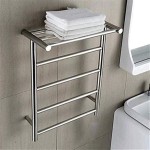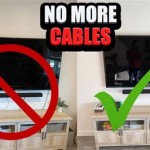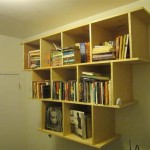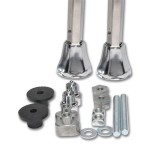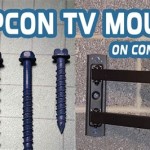Ideal Height for a Wall Mounted TV
Determining the optimal height for mounting a television on a wall involves several factors related to viewing comfort, room aesthetics, and specific use cases. A poorly positioned TV can lead to neck strain, eye fatigue, and an overall diminished viewing experience. This article explores the various considerations for choosing the ideal height, providing a framework for achieving comfortable and visually pleasing TV placement within a given space.
Understanding the Importance of Viewing Angle
The viewing angle, measured in degrees, is the vertical angle between the viewer's eyes and the center of the television screen. A comfortable viewing angle typically falls between 0 and 15 degrees below eye level. Exceeding this range can lead to discomfort, particularly during extended viewing periods. This principle forms the foundation for determining the appropriate mounting height.
Calculating the ideal viewing angle requires considering the typical viewing position. This involves identifying where viewers are most likely to sit or recline when watching television. Common viewing locations include sofas, chairs, and beds. The distance between the viewer and the screen influences the impact of the viewing angle; a greater distance allows for a slightly higher mounting position without compromising comfort.
The size of the television screen also plays a crucial role. Larger screens, with their increased vertical dimension, often necessitate a lower mounting position to maintain a comfortable viewing angle. Ignoring the screen size can result in the top portion of the screen being too high, forcing viewers to tilt their heads upwards for extended periods.
An essential step in determining the correct viewing angle is measuring the eye level of the viewers when seated in their typical viewing positions. This measurement serves as the reference point for calculating the optimal height for the center of the television screen. Failure to accurately measure eye level can lead to inaccurate calculations and a suboptimal viewing experience.
Some viewers may prefer a more personalized viewing angle. Factors such as individual height, posture, and specific viewing preferences can influence the ideal angle. It is important to consider these individual needs when determining the final mounting height. Trial and error, using temporary supports to test different heights, can be beneficial in identifying the most comfortable position.
Factors Influencing Mounting Height: Room Layout and Furniture
The layout of the room significantly affects the ideal television mounting height. Rooms with higher ceilings may accommodate a slightly higher mounting position without compromising the viewing angle. Conversely, rooms with lower ceilings typically require a lower mounting position to maintain visual comfort.
Existing furniture, such as consoles and entertainment centers, can also limit the available space for wall mounting. The height of the furniture should be taken into account to ensure the television is not mounted too high above it, creating a visually disjointed and potentially uncomfortable viewing experience. In some cases, it may be necessary to adjust the furniture arrangement to achieve the desired television placement.
Fireplaces often pose a challenge when determining the optimal television mounting height. Mounting a television above a fireplace is a common practice, but it is often ergonomically unsound. The height of the fireplace mantel typically places the television screen significantly above a comfortable viewing angle, leading to neck strain. Furthermore, the heat generated by the fireplace can potentially damage the television's internal components.
When mounting a television above a fireplace is unavoidable, it is crucial to select a mounting bracket that allows for tilting the television downwards. This tilting mechanism can help compensate for the elevated mounting position, improving the viewing angle and reducing discomfort. However, even with a tilting bracket, it is essential to consider the potential heat exposure and ensure adequate ventilation to protect the television.
The intended use of the room also influences the optimal mounting height. For example, in a bedroom where viewers primarily watch television while lying in bed, a higher mounting position may be necessary to provide a comfortable viewing angle. Conversely, in a living room where viewers are typically seated on a sofa, a lower mounting position is generally preferred.
Practical Guidelines for Determining Mounting Height
As a general guideline, the center of the television screen should be positioned at approximately eye level when seated in the typical viewing position. This rule of thumb provides a starting point for determining the optimal mounting height. However, it is essential to remember that this is just a guideline and should be adjusted based on the specific factors discussed previously.
For most living rooms, this typically translates to mounting the television so that the bottom of the screen is approximately 40 to 50 inches above the floor. This range allows for a comfortable viewing angle for most viewers when seated on a standard-height sofa. However, this height may need to be adjusted based on the height of the sofa and the size of the television screen.
For bedrooms, where viewers are often lying in bed, a higher mounting position may be necessary. In these cases, the bottom of the screen may need to be positioned as high as 60 to 70 inches above the floor. This higher position compensates for the reclined viewing angle and ensures comfortable viewing.
When mounting a television in a dedicated home theater, the seating arrangement and screen size play a crucial role in determining the optimal mounting height. In these settings, it is often beneficial to consult with a professional home theater installer to ensure the television is positioned for optimal viewing and sound quality.
It is always advisable to err on the side of mounting the television slightly lower rather than too high. A slightly lower mounting position is generally more comfortable than a position that requires viewers to tilt their heads upwards for extended periods. If necessary, the television can always be adjusted upwards slightly after the initial installation.
Before permanently mounting the television, it is recommended to temporarily position it at the proposed height and test the viewing angle. This can be accomplished using temporary supports, such as books or boxes. This allows viewers to experience the viewing angle firsthand and make any necessary adjustments before committing to the final mounting position.
Accurately measuring the distance between the mounting holes on the back of the television is critical for selecting the appropriate mounting bracket. The VESA (Video Electronics Standards Association) standard specifies the spacing of these mounting holes. Purchasing a mounting bracket that is compatible with the television's VESA pattern is essential for a secure and stable installation.
When running cables behind the wall, it is crucial to use in-wall rated cables that meet safety standards. These cables are designed to prevent fire hazards and ensure safe operation. Furthermore, it is important to consider the location of electrical outlets and cable connections when planning the cable routing. Concealing cables behind the wall provides a clean and professional look.
Properly securing the mounting bracket to the wall studs is essential for a safe and stable installation. Using a stud finder to locate the studs and using appropriate screws or bolts to attach the bracket is crucial. Failure to properly secure the bracket can result in the television falling from the wall, causing damage and potential injury.
The weight capacity of the mounting bracket should always exceed the weight of the television. Choosing a bracket with a higher weight capacity provides an extra margin of safety and ensures the bracket can adequately support the television. Overloading a mounting bracket can compromise its structural integrity and lead to a failure.

Tv Mounting Height Calculator

Wall Mounted Tvs What Is The Best Height To Mount A Livingroom Tv Nicoll Stewart

How High Should A 75 Inch Tv Be Mounted Hellotech

News Tv Wall Mount Installation Tips For The Experts Mhtg

Heightfinder Sanus

How High Should A Tv Be Mounted The Plug Hellotech

How High Should A Tv Be Mounted And What Is The Ideal Viewing Distance Cepro

How High To Mount Your Tv For The Perfect Viewing Experience

In Order To Determine The Height That Tv Should Be Mounted We First Need Know Size Of View Wall

The Perfect Position Wall Mounting Guide For Your Tv Ace Sydney Electricians

